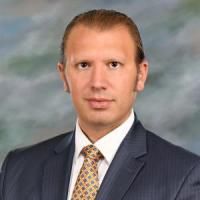Adult Scoliosis Deformity Surgery: Comparison of Outcomes Between One Versus Two Attending Surgeons.
Date
2017-07
Journal Title
Journal ISSN
Volume Title
Repository Usage Stats
views
downloads
Citation Stats
Attention Stats
Abstract
Study design
Retrospective review of prospectively collected data.Objective
Assess outcomes of adult spinal deformity (ASD) surgery performed by one versus two attending surgeons.Summary of background data
ASD centers have developed two attending teams to improve efficiency; their effects on complications and outcomes have not been reported.Methods
Patients with ASD with five or more levels fused and more than 2-year follow-up were included. Estimated blood loss (EBL), length of stay (LOS), operating room (OR) time, complications, quality of life (Health Related Quality of Life), and x-rays were analyzed. Outcomes were compared between one-surgeon (1S) and two-surgeon (2S) centers. A deformity-matched cohort was analyzed.Results
A total of 188 patients in 1S and 77 in 2S group were included. 2S group patients were older and had worse deformity based on the Scoliosis Research Society-Schwab classification (P < 0.05). There were no significant differences in levels fused (P = 0.57), LOS (8.7 vs 8.9 days), OR time (445.9 vs 453.2 min), or EBL (2008 vs 1898 cm; P > 0.05). 2S patients had more three-column osteotomies (3CO; P < 0.001) and used less bone morphogenetic protein 2 (BMP-2; 79.9% vs 15.6%; P < 0.001). The 2S group had fewer intraoperative complications (1.3% vs 11.1%; P = 0.006). Postoperative (6 wk to 2 yr) complications were more frequent in the 2S group (4.8% vs 15.6%; P < 0.002). After matching for deformity, there were no differences in (9.1 vs 10.1 days), OR time (467.8 vs 508.4 min), or EBL (3045 vs 2247 cm; P = 0.217). 2S group used less BMP-2 (20.6% vs 84.8%; P < 0.001), had fewer intraoperative complications (P = 0.015) but postoperative complications due to instrumentation failure/pseudarthrosis were more frequent (P < 0.01).Conclusion
No significant differences were found in LOS, OR time, or EBL between the 1S and 2S groups, even when matching for severity of deformity. 2S group had less BMP-2 use, fewer intraoperative complications but more postoperative complications.Level of evidence
2.Type
Department
Description
Provenance
Citation
Permalink
Published Version (Please cite this version)
Publication Info
Gomez, Jaime A, Virginie Lafage, Daniel M Sciubba, Shay Bess, Gregory M Mundis, Barthelemy Liabaud, Regina Hanstein, Christopher Shaffrey, et al. (2017). Adult Scoliosis Deformity Surgery: Comparison of Outcomes Between One Versus Two Attending Surgeons. Spine, 42(13). pp. 992–998. 10.1097/brs.0000000000002071 Retrieved from https://hdl.handle.net/10161/28383.
This is constructed from limited available data and may be imprecise. To cite this article, please review & use the official citation provided by the journal.
Collections
Scholars@Duke

Christopher Ignatius Shaffrey
I have more than 25 years of experience treating patients of all ages with spinal disorders. I have had an interest in the management of spinal disorders since starting my medical education. I performed residencies in both orthopaedic surgery and neurosurgery to gain a comprehensive understanding of the entire range of spinal disorders. My goal has been to find innovative ways to manage the range of spinal conditions, straightforward to complex. I have a focus on managing patients with complex spinal disorders. My patient evaluation and management philosophy is to provide engaged, compassionate care that focuses on providing the simplest and least aggressive treatment option for a particular condition. In many cases, non-operative treatment options exist to improve a patient’s symptoms. I have been actively engaged in clinical research to find the best ways to manage spinal disorders in order to achieve better results with fewer complications.

Peter Passias
Unless otherwise indicated, scholarly articles published by Duke faculty members are made available here with a CC-BY-NC (Creative Commons Attribution Non-Commercial) license, as enabled by the Duke Open Access Policy. If you wish to use the materials in ways not already permitted under CC-BY-NC, please consult the copyright owner. Other materials are made available here through the author’s grant of a non-exclusive license to make their work openly accessible.
